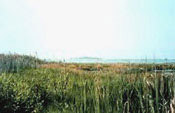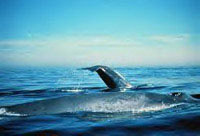|
|||
|
by Jackie Alan Giuliano, Ph.D
This new information clearly suggests that today's fishing and hunting quotas may be nearly meaningless. Such quotas are based on estimates of how many animals would be present if not subjected to human pressures of but a few years ago. The historical evidence is now showing that the actual populations - before human predation began - were exponentially greater than they are today. This new research, presented in the journal "Science" in a special July 27, 2001 issue, confirms what many ecologists and archeologists have suspected for some time - coastal human settlements have been depleting ocean resources for the last 10,000 years. This challenges the popular notion that native peoples had a small impact on the environment and lived in relative harmony with nature. The reality is that once humans began hunting, their appetite was insatiable and a pattern of imbalance started that may culminate in the complete collapse of some ecosystems. For example, the California coastline was once thick with underwater kelp forests and teeming with nearshore fishes. Predators like the sea otter, once numbering in the hundreds of thousands along the California coast, ate sea urchins, whose major diet is kelp. Native peoples hunted the sea otters in vast numbers and Europeans in the late 1800's hunted them nearly to extinction. As a result, the urchin populations skyrocketed, decimating the kelp.
There were so many sea turtles in the Caribbean that Christopher Columbus worried that his ship would run aground! Examining the middens, or kitchen refuse piles, that have been unearthed along the coastlines, the decline in marine populations can be clearly seen as fishing pressures increased. Studies of the refuse piles of the Amerindian peoples who first settled the area around the Caribbean show that they depended heavily on sea turtles for food as long ago as the seventh century. It is easy to catch the slow moving animals when they come ashore to lay eggs. Sea turtle populations that once measured in the tens of millions now are measured in the thousands. But with the passage of time, the presence of turtle shells in the middens decreases until they disappear almost completely. Clearly, the nesting colonies were wiped out. Species after species were fished out as the early peoples, and later the European settlers, moved from one food source to another, without any concern for sustaining anything into the future.
Without the oysters, the chemical content of the bay changed and became inhospitable to the once abundant manatees, giant sturgeon, alligators, and whales. Attempts are underway to try to regrow some of those beds, but they will never reach historic levels. It is now clearer than ever that every animal and every organism, no matter how small, plays a vital role in keeping the systems of the Earth healthy and functioning. Removing any species from the complex web of life disturbs the balance of the entire system, resulting in the impoverished life zones left today. The 19 authors of the "Science" article, "Historical Overfishing and the Recent Collapse of Coastal Ecosystems," examined data on the exploitation of our coastal resources that went back as far as 125,000 years. This allowed them to challenge the ideas that previously had been based on a few studies in the 1950s that had lasted only a few years. Without taking into account the lifespans of the sea creatures and the historical abundance of life, the assumptions that have been in science textbooks since those early inadequate studies may be quite wrong. Generations of people have grown up with a poor view of what the impact of humanity has been on the environment. Sea turtle populations The implications of this new data are sweeping and should change the way we view our interactions with the natural world. For example, quotas that have been established by the International Whaling Commission for the killing of whales must now be recognized as meaningless and be completely revised. Japan is given permission to kill 400 whales annually. They call it "research," but critics say it is just a front for commercialized whaling, since the meat is sold in Japanese restaurants. Norway also continues to hunt whales.
In the United States, numbers used to determine when it is OK to remove a species from the endangered list must be considered ridiculously low. For example, in 1994, the U.S. Fish and Wildlife Service declared the gray whale "recovered" and took the species off the Endangered Species List, declaring arrogantly in the June 16, 1994 edition of the Federal Register that the whale has recovered to near its estimated original population size. Today there are about 21,000 individuals in the wild. The estimates used to determine the "original" population numbers are from the 19th century, just before commercial whaling began. The new information in the "Science" study could mean that we shouldn't be content to cease protecting a species until it once again numbers in the millions. Once again, we are reminded that our perception of the true extent and importance of the web of life is woefully inadequate. We must erase any notions we have of how many individuals of a species are enough and try to remember that the Earth is a complex, living organism where every plant, every animal, every microbe evolved for a reason. The presence of large numbers of an animal should not be considered license to kill it, but rather an indication that we might have a chance to restore health to a threatened ecosystem. Human arrogance and our perception that we are the most important species has once again been challenged. In fact, we may actually be one of the least important species on the planet. How rarely we hear about a human actually contributing to the health of an ecosystem rather than its destruction. Let's get it straight once and for all, and start teaching our children that the raping and plundering of the Earth in the name of economic growth has taken us to the brink of disaster and must stop.
- Jackie Alan Giuliano
|
|||


![Giant kelp forest in California's
Channel Islands National Marine Sanctuary.
Photo courtesy NOAA
[National Oceanic & Atmospheric Administration]](http://www.bluegreenearth.com/site/images/features_NATURE/kelp.jpg) This started a destructive pattern
that turned much of the California coast into the barren rocks and sand we see there today. There are
fewer than 1,100 California sea otters surviving today, yet some people actually think that there are
too many. Fishermen often falsely blame them for the decline in abalone numbers when historical
records clearly show that human predation killed off the stocks of that animal.
This started a destructive pattern
that turned much of the California coast into the barren rocks and sand we see there today. There are
fewer than 1,100 California sea otters surviving today, yet some people actually think that there are
too many. Fishermen often falsely blame them for the decline in abalone numbers when historical
records clearly show that human predation killed off the stocks of that animal.
 In Chesapeake Bay, clear evidence exists
of a once balanced ecosystem that was teeming with life. Oyster beds were so thick that they posed navigational
hazards to passing ships. But the huge oysters made fine eating and they were soon gone. Their key place
in the ecosystem as water filters was ignored and lost, and the Chesapeake has become murky green and
unhealthy. The oysters once filtered the water so effectively that it was crystal clear.
In Chesapeake Bay, clear evidence exists
of a once balanced ecosystem that was teeming with life. Oyster beds were so thick that they posed navigational
hazards to passing ships. But the huge oysters made fine eating and they were soon gone. Their key place
in the ecosystem as water filters was ignored and lost, and the Chesapeake has become murky green and
unhealthy. The oysters once filtered the water so effectively that it was crystal clear.
 Historically, whale populations
numbered in the millions, a number that was necessary to insure the health of our oceans. Today, there
are a few hundred thousand of these animals left so to suggest, as Tokyo claims, that it is acceptable to
continue to hunt them because there are so many is ludicrous. Japanese ships recently returned from
their summer hunt in the northwestern Pacific after killing 158 whales.
Historically, whale populations
numbered in the millions, a number that was necessary to insure the health of our oceans. Today, there
are a few hundred thousand of these animals left so to suggest, as Tokyo claims, that it is acceptable to
continue to hunt them because there are so many is ludicrous. Japanese ships recently returned from
their summer hunt in the northwestern Pacific after killing 158 whales.
 Who is the FMSA?
Who is the FMSA?